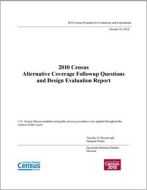2010 Census Alternative Coverage Followup Questions and Design Evaluation Report
2010 Census Alternative Coverage Followup Questions and Design Evaluation Report
Executive Summary
Ensuring that every person in the United States is counted once, only once, and in the right place is a fundamental goal of the decennial census. For many decades, the Census Bureau has evaluated coverage in each census and documented that some people are typically missed in the census. These people are referred to as census omissions. The Census Bureau has also documented that some people are counted in the wrong place and found evidence that some people are counted more than once during the census. Both of these errors are referred to as erroneous enumerations.
These types of coverage issues may have been self-identified by respondents when they completed their initial 2010 Census forms. There were questions on the initial 2010 Census forms that attempted to identify census omissions and erroneous enumerations. Census omissions were identified by a question that asked if there were additional people staying at the housing unit who were not included in the housing unit’s population count. This question was referred to as the undercount question. There were four types of census omission categories that were mentioned in the undercount question:
- Children, such as newborn babies or foster children
- Relatives, such as adult children, cousins, or in-laws
- Nonrelatives, such as roommates or live-in baby sitters
- People staying at the housing unit temporarily
Additionally, to identify erroneous enumerations, respondents were asked if people in the household sometimes lived or stayed somewhere else. This question was called the overcount question. The overcount question asked if each person sometimes lived or stayed elsewhere for one or more of these reasons:
- In college housing
- In a nursing home
- In the military
- In jail or prison
- At a seasonal or second residence
- For child custody
- For another reason
The Census Bureau attempted to resolve these coverage issues in the Coverage Followup operation. Coverage Followup was conducted via telephone interviews with respondents to determine if changes should be made to their housing-unit rosters as reported on their initial 2010 Census forms if the respondents had initially reported a coverage issue. The Coverage Followup questions probed to identify if people were missed or counted in error, and to collect missing demographic data for all people in the housing unit. Housing units could be selected for Coverage Followup for coverage issues besides the undercount and overcount questions. Those additional coverage issues that were resolved in Coverage Followup were:
- Large Households – Housing unit returns that could not collect all of the person data due to the space limitation of the initial 2010 Census form. (This was not really a coverage issue, but to collect information on more people and their demographic characteristics.)
- Count Discrepancies – Housing unit returns in which the number of people listed on the initial 2010 Census form did not match the population count provided by the respondent or enumerator.
- Administrative Records – Housing unit returns that were potentially missing people in the housing unit based on a comparison of the housing-unit roster from an administrative record with the housing unit roster from a 2010 Census return.
- Unduplication – Housing unit returns where the computer matching of the initial 2010 Census returns against themselves and against the universe of Group Quarter returns identified possible duplicate person links at various geographical locations.
Prior to the Coverage Followup telephone interviews, all of these coverage issues were divided into two groups based on a combination of reasons: how well they performed during the mid-decade census tests, the budget allocation assigned for the Coverage Followup operation, and the telephony constraints (volume and cost).
For the first group of coverage issues, all cases were sent to Coverage Followup because they were more likely to be successful in Coverage Followup at improving coverage, as determined through changes to housing-unit rosters with potential coverage issues. Below is a list of coverage issues included in the “production group”:
- Large Households
- Count Discrepancies
- Undercount – Children
- Undercount – Relatives
- Undercount – Nonrelatives
- Undercount - Temporary
- Overcount – College
- Overcount – Nursing Home
- Overcount – Military
- Overcount – Jail/Prison
- Overcount – Person Multiple (One person had multiple overcount categories.)
- Overcount – Household Multiple (Multiple people had multiple overcount categories.)
- Administrative Records
For the second group of coverage issues, only a sample of cases were sent for Coverage Followup because past research indicated that they were not as likely to be successful at improving coverage. Below is a list of coverage issues included in the “evaluation group”:
- Overcount – Seasonal/Second Residence
- Overcount – Child Custody
- Overcount – Another Reason
- Unduplication (For this research, we are only interested in those that also had one of the three evaluation overcount categories shown above.)
If a case had only one or more evaluation coverage issues, the results from this evaluation case were not included in the final 2010 Census counts. Most Coverage Followup cases had more than one coverage issue. There were some cases in the production group that also had one of the three evaluation coverage issues (i.e., those indicating that they lived at a seasonal or second residence, in child custody, or living elsewhere). Those cases were sent to Coverage Followup instead of being sampled and included for this research, and the results from those cases were included in census production files and the final 2010 Census counts.
This evaluation report looked into several research areas concerning Coverage Followup.
Others in Series
Publication
Publication
Publication




